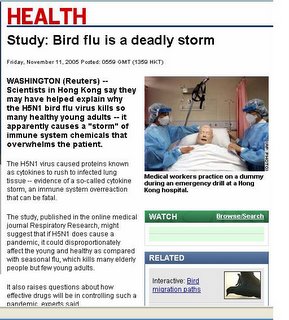
I've wallowed in the 394 pages of the HHS Pandemic Influenza Plan for the last day or so.
I've wasted my time.
The goal was to review the plan, come up with workable solutions and methods to put the plan into practice...everyday use. You know, that "All-Hazards" stuff I keep talking about.
A number of healthcare and allied healthcare groups have come out swinging against the Plan. Although I will not take such an extreme view, I would describe the plan as non-workable. The little voice keeps asking me "after the Anthrax attacks of 2001 and all the WMD training we've done; why don't we have this plan workable and ready to go now?" Another reason why all the "terrorism" and "WMD" training has been a waste...the EXACT same actions, materials, and protective measures employed against a biological intentional event could be used in the setting of a natural event...The flu. See the posting Its Time To Stop Training for Terrorist and WMD Events for my full rant on this.
Here is the problem(s): HHS estimates that the H5N1 avian flu could kill 1.9 million Americans and hospitalize another 10 million. This is based on the potential of the virus to spread rapidly world-wide, people being infectious and asymptomatic, simultaneous outbreaks, and demands on the health care system. Of similar concern is the potenial disruption of infrastructure including public safety due to widespread illness and death among workers and concern about on-going exposure to the virus. Yet, the Plan fails to identify any actionable precautions outside of standard body substance isolation and respiratory etiquette. The Plan also makes note of the Strategic National Stockpile (SNS), yet today, long after 9-1-1, few cities have the abilities or even the plans in place to receive and distribute the SNS. The Plan also calls on non-traditional and traditional responders, emergency and domestic support groups to all work together under the Federal Response Plan and the National Incident Management System (NIMS). The fact, again, is that..well let me ask you; do you know your role in NIMS or duties under the FRP? Chances are you don't. See the problem?
The good news is that we've been doing BSI/PPE and respiratory etiquette for a long, long time. The bad news is that we've failed to learn from the hysteria of "white powder" events and the SARS epidemic.
The bottom line:
- Wear a mask-N95 if you've got it, but wear a mask
- Put a mask on the patient- over the cannula or non-rebreather
- Cover your mouth when you cough or sneeze
- Wash your hands...and do it often
- Put all the Bio-Terror training into play in the event of any natural flu outbreak
- Don't bother reading the Pandemic Influenza Plan...It's a colossal waste of paper
